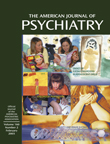To the Editor: In a recent issue, Harold W. Koenigsberg, M.D., et al.
(1) presented a study focused on understanding the nature of affective instability in patients with personality disorders. They hypothesized that patients with borderline personality disorder have greater mood instability than patients with other personality disorders. Further hypotheses were made regarding specific mood states. Mood variability was assessed with the Affective Lability Scale, a self-report instrument intended to measure mood swings from baseline to elevations in specific mood states. Patients with borderline personality disorder demonstrated significantly greater lability than the comparison group in terms of anger, anxiety, and oscillations between anxiety and depression after control for a group of covariates, including gender, age, past and current major depression, bipolar II disorder, and cyclothymia.
These positive findings notwithstanding, the Affective Lability Scale has not been well validated in psychiatric populations as a measure of affective variability. Dr. Koenigsberg et al. acknowledged the need to relate the Affective Lability Scale to contemporaneous ratings of affect. We recently examined the association between subscale scores on the Affective Lability Scale and the daily mood ratings of 21 psychiatric outpatients (eight men and 13 women; age: mean=37 years, SD=11) enrolled in a psychosocial/psychoeducational group intervention for individuals with recurrent suicidal behavior. Written informed consent was obtained from the participants. The participants completed the Affective Lability Scale upon entry into the study and then completed daily global mood ratings on a single-item visual analogue mood scale
(2) once in the morning and once in the evening over a 2-week period.
Two measures were derived from the ratings on the visual analogue scale: an affective lability score derived by computing the successive-difference mean square, which measured the average change in consecutive ratings over the period of study, and an affective intensity score derived by computing mean ratings over the period of study, measured in a positive direction. The results indicated that all Affective Lability Scale subscale scores were not significantly associated with the derived measure of affective lability (with Pearson’s correlations ranging from –0.16 to 0.07). However, the Affective Lability Scale subscale scores for depression (r=–0.56, p<0.05), elation (r=–0.62, p<0.01), anxiety/depression (r=–0.68, p<0.01), and depression/elation (r=–0.71, p<0.001) were all significantly associated with the derived measure of affective intensity. Moreover, the associations of Affective Lability Scale subscales with affective intensity were significantly stronger than the correlations with our measure of affective lability for elation (z=–2.78, p<0.01), anxiety/depression (z=–3.15, p<0.01), and depression/elation (z=–3.62, p<0.001), with nonsignificant findings for the Affective Lability Scale subscale scores for depression (z=–1.82, p<0.10) and anxiety (z=–1.77, p<0.10). These findings raise questions about the validity of considering scores on the Affective Lability Scale to be measures of affective variability, and the results demonstrate a possible conflation of Affective Lability Scale scores with affective intensity. We agree with Dr. Koenigsberg et al. that measures of affective instability with established psychometric properties need to be developed and given research priority if this psychopathologic feature is to be better understood.

